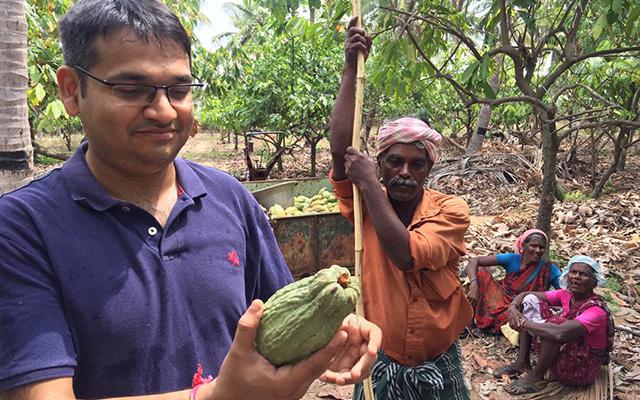“When you have good grapes in hand, you decide to make grape juice with it or fine wine! Cacao is no different.“
– L Nitin Chordia, India’s 1st certified chocolate taster
In India Dark chocolates are increasingly being considered a healthier option to snack on and is backed by an increasing demand. Dark chocolates can range from 60% dark all the way upto 100% dark. A fine flavoured dark chocolate must contain more than 73% cacao to be considered suitable to deliver the health benefits. This means 73% of the contents of the chocolate is derived directly from cocoa. (Read: which dark chocolate is good for you). The more the % of the dark chocolate the more cocoa is used. An average mass produced dark chocolate available to an Indian consumer contains more sugar than a traditional Indian sweet and contains way lesser cacao as an ingredient than a typical dark chocolate should contain!
Most of the dark chocolates available in India are in the range of 50-55%. The reason for this is rather straightforward. The mass market dark chocolate is made from cocoa beans which are not capable of delivering fine flavor, are usually bitter, highly acidic, highly astringent, certainly have primary processing defects and are paid very less for! This is primarily due to bad harvesting and post harvesting processes/protocols. Have you noticed how most mass manufactured chocolate taste predominantly of vanilla? To hide the above defects and inheritances from cacao, mass producers add sugar, vanilla flavouring and milk powders while processing to make their chocolate palatable. Let us call these as masking agents. The key is to have good quality base raw material to start with (cacao in this case) if our aim is to make good high % dark chocolate.
“Garbage in, garbage out”.
– L Nitin Chordia, India’s 1st certified chocolate taster
Cocoa content in dark chocolate is always more than the cocoa content in a milk chocolate. White chocolate on the other hand may use little or no cocoa and milk chocolates contain less than 20% cocoa and the other ingredients include processed milk powder, sugar and emulsifiers. In compounds, which are the most produced category in India, processed cacao powder, hydrogenated vegetable oil and sugar make up most of the ingredients. Vanilla flavouring and sugar are again the most common masking agents used!
The cocoa powder used in large quantity in compound is almost always imported and oils are farmed and processed in quite an un-sustainable fashion. If carbon impact is anything to go by, compounds would top the contribution list. Compounds contribute negatively to our import/export balance and robs from the Indian cacao farmer a chance for their cacao to be used! Most often, the excuse is that Indian cacao beans do not meet the requirements and the standards set by the large buyer and at some point it is cheaper to import cacao then buy locally. Mass market chocolate makers can also be discredited to offer Indian consumers, products which would simply not stand a chance to sell in most other developed countries!
With the bean to bar revolution taking place now globally and in India, chocolate makers are looking at sourcing beans that can deliver better and interesting flavours, are defect free and which help them make higher % dark chocolate without adding masking agents. However, the current Indian cacao does not lend itself to producing fine flavoured chocolate due to lack of post harvesting facilities and know-how at the farmer level.
India would be the winner!
– L Nitin Chordia
With improved flavour profile of Indian cacao, producers will be able to make higher % dark chocolate, our reliance on imported raw materials would reduce thus reducing imports and also carbon emissions. As a result, cacao farmers would certainly be paid a higher price for their efforts! A winning situation for India!
There are more benefits of the bean to bar revolution to the country. Click to read more: https://cocoatrait.com/chocolates/why-choose-bean-to-bar-chocolate-made-in-india/

